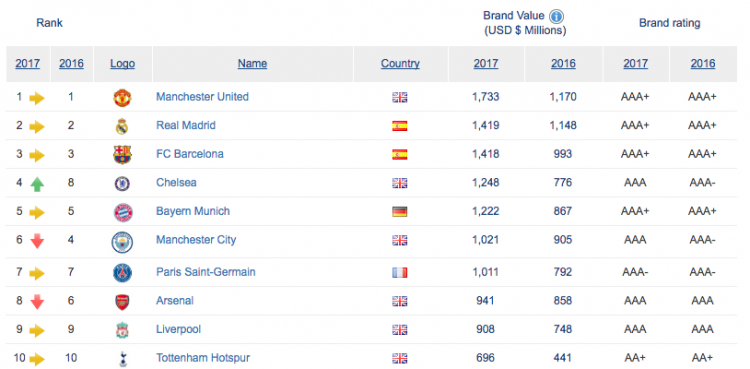Valuation and strategy consultancy Brand Finance has conducted its an annual study, calculating the brand strength and value of the world’s leading football club brands. The Brand Finance Football 50 is the first of any kind to take into account the full sporting results of the 2016/17 season. Read the full report here.
In this year’s results Spanish giants Real Madrid have overtaken rivals Barcelona has teh most powerful football brand on the planet. While Manchester United is the most valuable brand at US$1.733 billion.
The brand power of both Spanish clubs was already formidable and unmatched by any other club worldwide. The fierce rivalry of El Clásico, their dominance on the European stage and footballing styles, that are as beautiful as they are effective, served to create brands that are unmatched by German, French, English or Italian rivals. Barcelona has always remained just fractionally ahead of Real however, until now. Real’s brand strength score is up from 94.6 in 2016 to 96.1, edging ahead of Barcelona on 95.4, secured after wresting La Liga title from Barça and claiming a record 12th Champions League victory.
However, whilst Real can bask in the glory of its unparalleled reputation, it could be doing a lot more to capitalise on its on-pitch success. Despite being football’s most powerful brand, in terms of brand value, it still trails Manchester United by a considerable margin. United, despite finishing a disappointing 6th in the Premier League, is the most valuable brand in football, worth US$1.733 billion to Real’s US$1.419 billion.
You can read the full list of most valuable brands here.
United’s success is partly the result of an enduring halo effect from the good times under Alex Ferguson. However, the most crucial ingredient has been the club’s commercial nous and ability to convert its success into lucrative deals across dozens of industry sectors and national territories. In contrast, while Real has blockbuster deals such as its reported billion euro agreement with Adidas, it has not leveraged its brand equity to the same extent as United, failing to pursue the same range of partnerships.
Real could perform significantly better in growth markets outside Europe too. In some, such as the Middle East, Real is popular, yet Brand Finance research into the vast and therefore critical Chinese market demonstrates that Real has a lot of work to do; it lags not just United but also Bayern Munich in popularity.
Premier League clubs continue to lead the world when it comes to commercialising their brands; six of the top ten most valuable football brands are English. Title rivals Chelsea and Tottenham have recorded some of the biggest gains this year after successful seasons that saw Chelsea regain its status as England’s best under dynamic new manager Antonio Conte.
Commercially, Chelsea stand to gain significantly through a reported £900 million, 15 year deal with Nike as well as from a near 50 per cent increase to the capacity of Stamford Bridge. Tottenham is also expanding its home; the new White Hart Lane has been innovatively designed and will offer 61,000 spectators the opportunity to see Spurs on home turf. Tottenham’s brand value is up 58 per cent on last year and Chelsea’s 61 per cent to US$1.248 billion.
All Premier League teams continue to benefit from the vast revenues brought in by the latest broadcasting rights deal with Sky and BT. The relatively equitable split is particularly helpful to smaller clubs and helps to explain how a club such as Bournemouth (which joined the Premier League just two years ago and comes from a town of just 180,000 inhabitants) controls a more valuable brand than much longer established European top tier clubs such as Olympique Lyonnais, Inter Milan, and AS Roma. The costs of missing out on Premier League status are clear too. Another season in the Championship for Aston Villa and relegation for Sunderland see both drop out of this year’s list.
Australian and New Zealand Football Codes Lack Global Reach
This year’s Brand Finance Football 50 again highlights the market challenges for Australia’s football codes. Brand Finance managing director, Mark Crowe comments, “The AFL and NRL have dominated the commercial landscape in Australia and will continue to leverage their concentrated market strength, especially in regard to media rights and in particular the opportunities presented by new and evolving digital platforms.
“However, market expansion will necessitate an increased international outlook as evidenced by AFL’s recent foray into China and Rugby League’s World Cup this year”.
Crowe added, “The stronger global footprint for rugby union and football (soccer) conversely presents challenges for Super Rugby and the A League given that the market forces for salaries makes it impossible to compete against what is on offer in Europe and increasingly Asia.”
Super Rugby has sought growth through entry into emerging markets. Crowe said, “Super Rugby’s strategic expansion has been stymied by the dilution of playing talent and an inability of many teams to engage with their core market, let alone extend their reach into new markets”. Crowe continues, “Super Rugby has failed to capitalise on the growing strength of the international game. Poor brand strength will continue to drive down the brand value of the Super Rugby teams”.
By way of comparison, Brand Finance estimates the All Black’s brand value to be worth more than $200m USD. This would equate to the 30th ranking in this year’s Football 50. Crowe says, “The All Blacks strength is the ability to transcend the game of rugby union and become a truly global sporting brand that can leverage commercial opportunities across the non-traditional Asian and American markets”.









